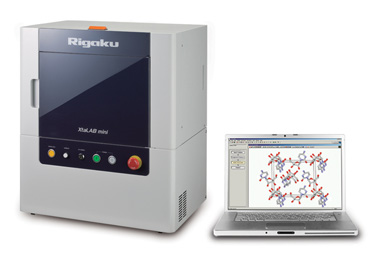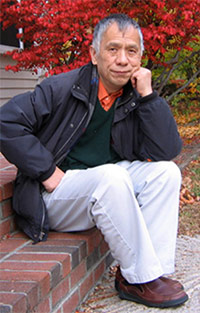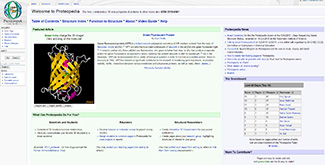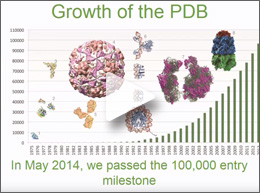|
Crystallography
in the news
August 3, 2015. Researchers, led by Martyn P. Coles at Victoria University (Wellington), have managed to isolate a monomeric bismuth radical that is stable in the solid state. Overcoming problems of previous studies on heavy group 15 radicals, this new radical has been characterized by both electron paramagnetic resonance (EPR) and X-ray crystallography.
August 6, 2015. In a collaborative study between Sanford Burnham Prebys Medical Discovery Institute (SBP) and the Argonne National Laboratory, scientists have used a highly specialized X-ray crystallography technique to solve the protein structure of hypoxia-inducible factors (HIFs), important regulators of a tumor's response to low oxygen (hyopoxia).
August 6, 2015. Researchers from DESY in Germany, the Paul Scherrer Institute in Switzerland and Diamond Light Source in the UK have developed a new type of sample holder for "serial protein crystallography". The holder consists of a single crystal of silicon with a regular array of pores.
August 12, 2015. An international collaboration including scientists from the Florida campus of The Scripps Research Institute (TSRI) has determined the structure of a plant hormone that plays a crucial role in regulating plants' responses to insects and disease-causing microorganisms as well as normal growth and development. The work focused on a plant hormone called jasmonate and two proteins involved in its molecular signaling, MYC and JAZ.
August 13, 2015. A new study, by researchers at University of California, San Diego School of Medicine, revises the previously published structure of Protein Kinase C enzyme, and proposes new strategies to turn the enzyme "on" to treat cancer or "off" to treat neurodegenerative diseases.
August 17, 2015. A recent experiment sponsored by CASIS, the Center for the Advancement of Science in Space, describes the use of space-grown crystals to generate larger, more homogenous protein crystals for neutron diffraction. A more enhanced method for revealing the detail of a protein's structure than traditional X-rays, neutron diffraction holds great promise for improving drug design by enabling scientists to make better maps of proteins with more detail.
August 17, 2015. Scientists, led by Professor Axel Brunger at the Stanford School of Medicine, have revealed never-before-seen details of how our brain sends rapid-fire messages between its cells. They mapped the structure of a two-part protein complex that controls the release of neurotransmitters. Scientists found that when the SNAREs and synaptotagmin-1 join up, they act as an amplifier for a slight increase in calcium concentration, triggering a gunshot-like release of neurotransmitters.
August 20, 2015. An international group of researchers led by Carnegie Mellon University physicists Mathias Lösche and Frank Heinrich has established the structure of an important tumor suppressing protein, PTEN. Their findings provide new insights into how the protein regulates cell growth and how mutations in the gene that encodes the protein can lead to cancer.
August 20, 2015. Researchers at Imperial College London, with collaborators at Peking University, Pennsylvania State University and University of Wisconsin-Madison, have exposed a chink in the armour of bacteria, with a new discovery about a protein that controls bacterial defenses. The new research shows that a protein called sigma54 holds a bacterium's defenses back until it encounters stress, at which point the protein rearranges its structure to trigger the defenses into action.
Product spotlight: XtaLAB mini
The Rigaku XtaLAB mini benchtop X-ray crystallography system is a compact single crystal X-ray diffractometer designed to produce publication-quality 3D structures. The perfect addition to any synthetic chemistry laboratory, the XtaLAB mini will enhance research productivity by offering affordable structure analysis capability without the necessity of relying on a departmental facility. With the XtaLAB mini, you no longer have to wait in line to determine your structures. Instead your research group can rapidly analyze new compounds as they are synthesized in the lab.

Visit Rigaku.com for more information about the XtaLAB mini.
Lab spotlight: Jia-huai Wang Laboratory
Dr. Jia-huai Wang
Dana-Farber Cancer Institute
Department of Medical Oncology
Department of Cancer Biology
Harvard Medical School
Department of Pediatrics
Department of Biological Chemistry and Molecular Pharmacology

Dr. Wang has been working on structural biology for several decades. His work includes insulin, plant toxins, RNA and DNA/protein complex. Over the last 20 years he has been focusing on structures of cell surface receptors that play critical roles in immune system and nervous system.
Recently his laboratory has been primarily engaged in structural studies on cell surface receptors in immune and neural systems using X-ray crystallography and some other biochemical and biophysical techniques. In particular they have programs for structural investigation of cell surface receptors and their biological significance, structural virology, and structural neuroscience.

Recently a postdoctoral job opening has been posted that looks like a very exciting opportunity for some lucky scientist:
Ph.D. Biochemist/structural biologist
Exciting opportunity for a biochemist/structural biologist to work with a
multidisciplinary team on HIV-1 vaccine design targeting the gp140 membrane proximal external region (MPER). Expertise of current team members includes X-ray crystallography, NMR, cryoEM, immunology and biomaterials. Skills required for this new position are recombinant protein expression and purification, with knowledge of structural biology. Knowledge of membrane proteins, liposomes and/or nanodiscs is highly desirable. Ph.D. or equivalent is required. Send a current C.V. and names of three references to
Drs. Jia-huai Wang and Ellils Renherz at jwang@crystal.harvard.edu.
Useful link: Proteopedia
Proteopedia is a collaborative, 3D web-encyclopedia of protein, nucleic acid and other biomolecule structures. Created as a means for communicating biomolecule structures to a diverse scientific audience, Proteopedia presents structural annotation in an intuitive, interactive format and allows members of the scientific community to easily contribute their own annotations.

Selected
recent crystallographic papers
Low-Z polymer sample supports for fixed-target serial femtosecond X-ray crystallography. Feld, Geoffrey K.; Heymann, Michael; Benner, W. Henry; Pardini, Tommaso; Tsai, Ching-Ju; Boutet, Sébastien; Coleman, Matthew A.; Hunter, Mark S.; Li, Xiaodan; Messerschmidt, Marc; Opathalage, Achini; Pedrini, Bill; Williams, Garth J.; Krantz, Bryan A.; Fraden, Seth; Hau-Riege, Stefan; Evans, James E.; Segelke, Brent W.; Frank, Matthias. Journal of Applied Crystallography. Aug2015, Vol. 48 Issue 4, p1072-1079. 8p. DOI: 10.1107/S1600576715010493.
New ruthenium(II) coordination compounds possessing bidentate aminomethylphosphane ligands: synthesis, characterization and preliminary biological study in vitro. Plotek, Michał; Starosta, Radosław; Komarnicka, Urszula K.; Skórska-Stania, Agnieszka; Jezowska-Bojczuk, Małgorzata; Stochel, Graźyna; Kyziol, Agnieszka. Dalton Transactions: An International Journal of Inorganic Chemistry. 8/21/2015, Vol. 44 Issue 31, p13969-13978. 10p. DOI: 10.1039/c5dt01119a.
Combining 'dry' co-crystallization and in situ diffraction to facilitate ligand screening by X-ray crystallography. Gelin, Muriel; Delfosse, Vanessa; Allemand, Frédéric; Hoh, François; Sallaz-Damaz, Yoann; Pirocchi, Michel; Bourguet, William; Ferrer, Jean-Luc; Labesse, Gilles; Guichou, Jean-François. Acta Crystallographica: Section D. Aug2015, Vol. 71 Issue 8, p1777-1787. 11p. DOI: 10.1107/S1399004715010342.
A comparative study on the quality of protein crystals obtained using the cross-diffusion microbatch and sitting-drop vapor diffusion methods. Hou, Hai; Wang, Bo; Hu, Shan-Yang; Wang, Jing-Zhang; Zhu, Peng-Fei; Liu, Yue; Wang, Meng-Ying; Yin, Da-Chuan. CrystEngComm. 8/7/2015, Vol. 17 Issue 29, p5365-5371. 7p. DOI: 10.1039/c5ce00551e.
Single in the (Cell) City: a protein-folding story. Plochowietz, Anne; Kapanidis, Achillefs N. Nature Methods. Aug2015, Vol. 12 Issue 8, p715-716. 2p. DOI: 10.1038/nmeth.3491.
Defined PEG smears as an alternative approach to enhance the search for crystallization conditions and crystal-quality improvement in reduced screens. Chaikuad, Apirat; Knapp, Stefan; von Delft, Frank. Acta Crystallographica: Section D. Aug2015, Vol. 71 Issue 8, p1627-1639. 13p. DOI: 10.1107/S1399004715007968.
Synthesis and crystal structure of new dicopper(II) complexes having asymmetric N,N'-bis(substituted)oxamides with DNA/protein binding ability: In vitro anticancer activity and molecular docking studies. Zheng, Kang; Zhu, Ling; Li, Yan-Tuan; Wu, Zhi-Yong; Yan, Cui-Wei. Journal of Photochemistry & Photobiology B: Biology. Aug2015, Vol. 149, p129-142. 14p. DOI: 10.1016/j.jphotobiol.2015.05.014.
Fusion of selected regions of mycobacterial antigens for enhancing sensitivity in serodiagnosis of tuberculosis. Afzal, Madeeha; Khurshid, Sana; Khalid, Ruqyya; Paracha, Rehan Zafar; Khan, Imran H.; Akhtar, M. Waheed. Journal of Microbiological Methods. Aug2015, Vol. 115, p104-111. 8p. DOI: 10.1016/j.mimet.2015.06.003.
Crystal structure of designed PX domain from cytokine-independent survival kinase and implications on evolution-based protein engineering. Shultis, David; Dodge, Gregory; Zhang, Yang. Journal of Structural Biology. Aug2015, Vol. 191 Issue 2, p197-206. 10p. DOI: 10.1016/j.jsb.2015.06.009.
The Structure and Interactions of Periplasmic Domains of Crucial MmpL Membrane Proteins from Mycobacterium tuberculosis. Chim, Nicholas; Torres, Rodrigo; Liu, Yuqi; Capri, Joe; Batot, Gaëlle; Whitelegge, Julian P.; Goulding, Celia W. Chemistry & Biology. Aug2015, Vol. 22 Issue 8, p1098-1107. 10p. DOI: 10.1016/j.chembiol.2015.07.013.
Self-assembly gets physical. Olson, Arthur J. Nature Nanotechnology. Aug2015, Vol. 10 Issue 8, p728-728. 1p. DOI: 10.1038/nnano.2015.172.
From G Protein-coupled Receptor Structure Resolution to Rational Drug Design. Jazayeri, Ali; Dias, Joao M.; Marshall, Fiona H. Journal of Biological Chemistry. 8/7/2015, Vol. 290 Issue 32, p19489-19495. 7p. DOI: 10.1074/jbc.R115.668251.
Mechanism of NH4+ Recruitment and NH3 Transport in Rh Proteins. Baday, Sefer; Orabi, Esam A.; Wang, Shihao; Lamoureux, Guillaume; Bernèche, Simon. Structure. Aug2015, Vol. 23 Issue 8, p1550-1557. 8p. DOI: 10.1016/j.str.2015.06.010.
Methods for analysis of size-exclusion chromatography-small-angle X-ray scattering and reconstruction of protein scattering. Malaby, Andrew W.; Chakravarthy, Srinivas; Irving, Thomas C.; Kathuria, Sagar V.; Bilsel, Osman; Lambright, David G. Journal of Applied Crystallography. Aug2015, Vol. 48 Issue 4, p1102-1113. 12p. DOI: 10.1107/S1600576715010420.
Detection of trans-cis flips and peptide-plane flips in protein structures. Touw, Wouter G.; Joosten, Robbie P.; Vriend, Gert. Acta Crystallographica: Section D. Aug2015, Vol. 71 Issue 8, p1604-1614. 11p. DOI: 10.1107/S1399004715008263.
Modularity of Protein Folds as a Tool for Template-Free Modeling of Structures. Vallat, Brinda; Madrid-Aliste, Carlos; Fiser, Andras. PLoS Computational Biology. 8/7/2015, Vol. 11 Issue 8, p1-16. 16p. 2 Diagrams, 2 Charts, 1 Graph. DOI: 10.1371/journal.pcbi.1004419.
High-resolution structures of the d-alanyl carrier protein (Dcp) DltC from Bacillus subtilis reveal equivalent conformations of apo- and holo-forms. Zimmermann, Stephan; Pfennig, Sabrina; Neumann, Piotr; Yonus, Huma; Weininger, Ulrich; Kovermann, Michael; Balbach, Jochen; Stubbs, Milton T. FEBS Letters. Aug2015, Vol. 589 Issue 18, p2283-2289. 7p. DOI: 10.1016/j.febslet.2015.07.008.
Sequence, structure, and cooperativity in folding of elementary protein structural motifs. Lai, Jason K.; Kubelka, Ginka S.; Kubelka, Jan. Proceedings of the National Academy of Sciences of the United States of America. 8/11/2015, Vol. 112 Issue 32, p9890-9895. 6p. DOI: 10.1073/pnas.1506309112.
Membrane Protein Structure, Function, and Dynamics: a Perspective from Experiments and Theory. Cournia, Zoe; Allen, Toby; Andricioaei, Ioan; Antonny, Bruno; Baum, Daniel; Brannigan, Grace; Buchete, Nicolae-Viorel; Deckman, Jason; Delemotte, Lucie; Val, Coral; Friedman, Ran; Gkeka, Paraskevi; Hege, Hans-Christian; Hénin, Jérôme; Kasimova, Marina; Kolocouris, Antonios; Klein, Michael; Khalid, Syma; Lemieux, M.; Lindow, Norbert. Journal of Membrane Biology. Aug2015, Vol. 248 Issue 4, p611-640. 30p. DOI: 10.1007/s00232-015-9802-0.
Crystal Structure of Mg2+ Containing Hemopexin-Fold Protein from Kabuli Chana (Chickpea-White, CW-25) at 2.45 Å Resolution Reveals Its Metal Ion Transport Property. Kumar, Suresh; Singh, Avinash; Yamini, Shavait; Dey, Sharmistha; Singh, T. Protein Journal. Aug2015, Vol. 34 Issue 4, p284-290. 7p. DOI: 10.1007/s10930-015-9624-z.
The study of unfoldable self-avoiding walks – Application to protein structure prediction software. Guyeux, Christophe; Nicod, Jean-Marc; Philippe, Laurent; Bahi, Jacques M. Journal of Bioinformatics & Computational Biology. Aug2015, Vol. 13 Issue 4, p-1. 36p. DOI: 10.1142/S0219720015500092.
Book review:
The Science of Interstellar, by Kip Thorne
W. W. Norton & Company, New York, 2014, 336 pages, ISBN-13:
978-0393351378
Kip Thorne's The Science of Interstellar is a phenomenal work of science writing. As the title suggests, Thorne's book details the scientific explanations for the phenomena portrayed in Christopher Nolan's blockbuster film Interstellar. Thorne, the Feynman Professor of Theoretical Physics Emeritus at California Institute of Technology, was not only the scientific advisor for Interstellar, but he was also one of the film's executive producers. His book is designed to appeal to any viewer of the film who seeks to discern its science fact from its science fiction.
Thorne thus classifies each chapter as based on (a) truth, (b) educated guess, or (c) speculation, allowing his audience to better understand where artistic license was taken with the regard to the film's scientific material. Thorne's prose is quick and easy to read, allowing his book to appeal to the film's broad audience, and the book is chock-full of colorful and informative illustrations that help bring Thorne's detailed explanations to life. It reminded me of another one of my favorite works of science writing, Stephen Hawking's The Grand Design, which also made excellent use of illustrations to help its readers visualize complex concepts in theoretical physics.
Chapter by chapter, Thorne addresses each of the film's scientific topics and argues that, unlike many films of the space exploration genre, Interstellar's plot is rooted far more deeply in science fact than science fiction. One of its seminal moments involves the main character, Cooper, traveling through a black hole, called Gargantua, from a distant galaxy back to our own, and surviving the journey, which seems extraordinary. However, Thorne not only approved such a journey but explains quite eloquently in the book how Cooper could have survived it.
Interestingly enough, Thorne was also the scientific advisor for Carl Sagan's novel Contact and the film adaptation starring Jodie Foster. Thirty years ago, Sagan asked Thorne to critique the science in his manuscript. Sagan had his main character, Dr. Eleanor Arroway (played by Foster in the film) travelling through a black hole to get from one galaxy to another, across the vast universe. Thorne told Sagan that this was not possible, as Dr. Arroway would be killed by the black hole's singularity after crossing its horizon. He suggested Sagan use a traversable wormhole instead.
In the thirty years between his work on Contact and his work on Interstellar, Thorne went from believing travel through a black hole would be fatal to human life to believing that it could be possible. Such a change in philosophy reflects the number of advancements in the field of theoretical physics and scientists' understanding of our universe in the past three decades.
Thorne's book was an entertaining and enlightening read—I thoroughly enjoyed it and highly recommend it to any fan of the film who wants to dig deeper. And for those who still want to learn more, Thorne provides a chapter-by-chapter list of further reading suggestions.
Jeanette S. Ferrara,
NYU Journalism – SHERP,
Class of 2017
|










